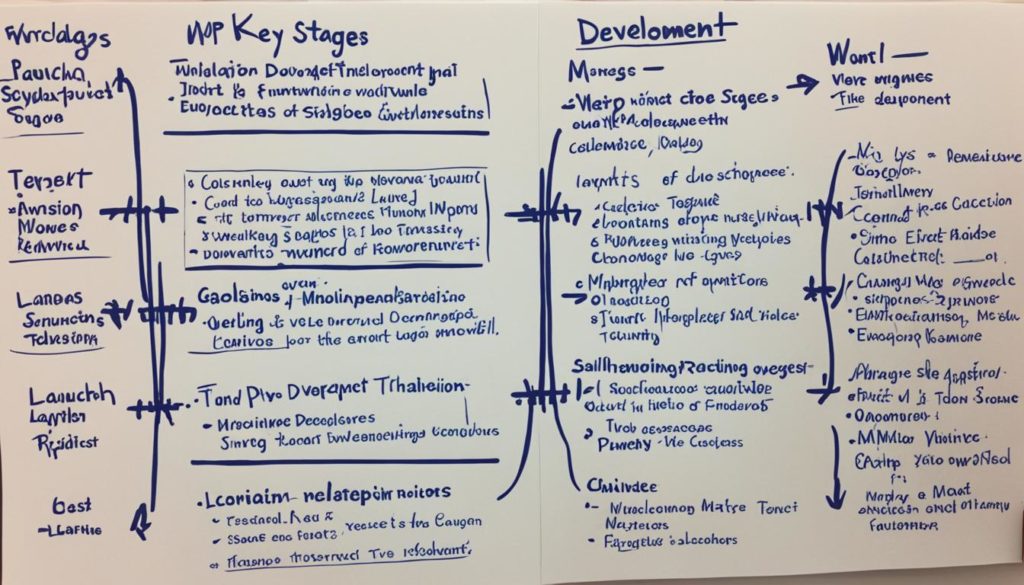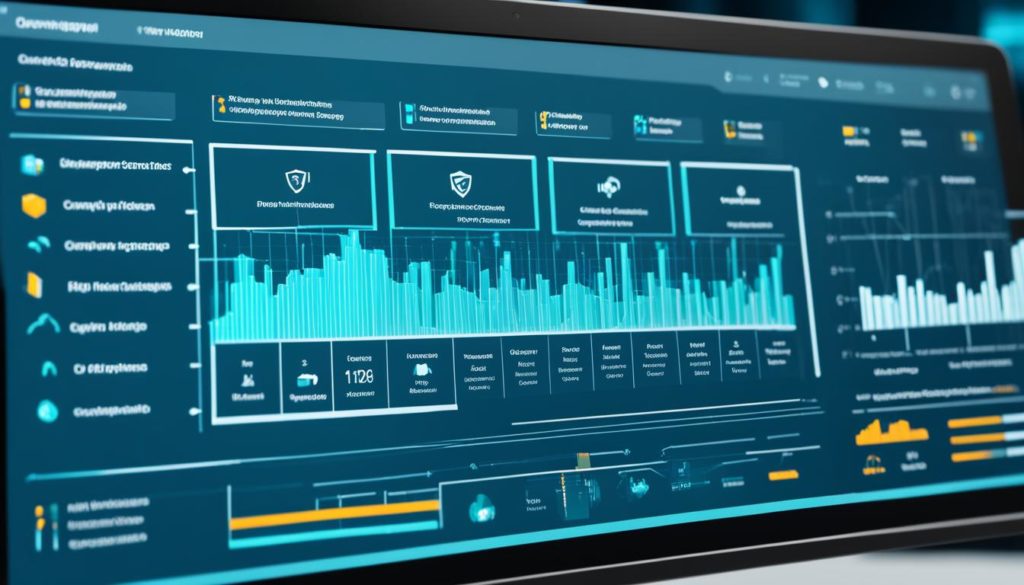
Did you know that keeping 5% more customers can boost profits by up to 95%? This shows the power of tracking how happy customers are. Since 2018, though, customer happiness has dropped, hurting business results. Now, more than ever, it’s vital to listen to customer feedback to grow sales and keep loyal customers.
Companies look at customer happiness scores to see how satisfied people are with what they sell. They also spot ways to get better and keep customers from leaving. Leaders in the field, like Mario DeAlmeida from HotHeadTech.com, know that happy customers are key to success.
Key Takeaways
- Increasing customer retention by 5% can boost profits by 25% to 95%.
- Customer satisfaction ratings have declined since 2018.
- Effective customer satisfaction measurement is essential to analyze feedback.
- Improving customer experience can significantly drive sales and business performance.
- Businesses need to understand customer behavior to make informed decisions.
Understanding the Importance of Customer Satisfaction
In B2B transactions, building strong business relationships is key. We use customer satisfaction metrics to gain insights into how well we’re doing. By listening and asking for feedback, we find out what we’re good at and what needs work.
Measuring customer satisfaction is vital for checking the quality of our service. It helps us see how clients view our services. This also aids in creating loyal customers.
Recording how we satisfy customers is crucial in B2B relations. Yet, only 39% of B2B companies do it. This shows we need better measuring methods.
Measuring customer experiences tells us how to keep our standards high. It gives us clear feedback. This lets us improve customer relationships and be outstanding in every interaction.
| Metric | Description | Importance |
|---|---|---|
| Net Promoter Score (NPS) | Measures customer loyalty and likelihood to recommend | High |
| Customer Satisfaction Score (CSAT) | Assesses overall satisfaction with the product or service | Medium |
| Customer Effort Score (CES) | Evaluates the ease of customer interactions | Medium |
Methods for Measuring Customer Satisfaction
It’s key for all businesses to understand how satisfied their customers are. By using various ways like surveys, feedback, and the Net Promoter Score (NPS), we can learn a lot about what customers think and want.
Surveys and Feedback
Surveys work well to check how happy customers are. They can happen right after buying or at other times. It’s good to ask different types of questions and keep them short so more people answer them. Online tools make it easy to collect and look at the answers, helping us know what to do next.
Check out how to measure customer happiness in more.
Net Promoter Score (NPS)
The Net Promoter Score (NPS) tells who might recommend us to others. It gives scores between 0-10, with high scores being good. This method makes it straightforward to understand how loyal our customers are.
To find out more on using NPS, click here.
Customer Feedback and Reviews
Checking reviews and feedback online shows us real opinions about what we offer. Tools like Awario and Brand24 help watch for mentions across social media. Pairing this info with survey data gives a full picture of how people feel about us.
Customer Interviews and Focus Groups
Talking directly to customers gives us deeper insights. Interviews and focus groups let us really understand their needs and opinions. They make our feedback stronger, ensuring we really hear what our customers say.
For more tips on these methods, see this helpful guide.
Key Customer Satisfaction Metrics to Watch
Understanding the right customer satisfaction metrics is crucial for a business’s growth and success. Since 2018, customer satisfaction has been dropping. This shows companies need effective ways to monitor and handle customer feelings.
The Net Promoter Score (NPS) is a vital metric. It shows how likely customers are to suggest your business to others. Retently’s data reveals that Insurance and Financial Services have the highest NPS. On the other hand, Communication and Media sectors are at the bottom.
The Customer Satisfaction Score (CSAT) is also key. Its scores range from 0% to 100%, based on customer feedback. It checks how happy customers are with certain products or services. For example, Exempli’s 2022 report found that 61% of customers would spend 5% more for a better experience.
In today’s digital age, the Customer Effort Score (CES) is becoming crucial. Companies like LiveChat achieve an 85% satisfaction rate by responding in five seconds. This is important because 60% of consumers leave brands after bad contact center experiences.
The customer churn rate (CCR) is critical yet often ignored. It shows how many customers stop doing business with you over time. A high churn rate can signal customer unhappiness. To fight this, businesses work hard to keep their customers.
Businesses must also watch abandonment rates and response times for complete KPI tracking. The Baymard Institute reported a 70% shopping cart abandonment rate on average. This often happens due to complicated checkout processes, pointing to an area needing fixes.
Below is a table summarizing key customer satisfaction metrics and their business impact:
| Metric | Description | Impact |
|---|---|---|
| Net Promoter Score (NPS) | Measures customer loyalty through likelihood of recommendations. | High NPS correlates with increased customer retention. |
| Customer Satisfaction Score (CSAT) | Evaluates overall satisfaction with products/services. | Higher CSAT indicates better customer experiences and loyalty. |
| Customer Effort Score (CES) | Assesses ease of customer interactions with the company. | Lower effort scores improve customer satisfaction and retention. |
| Customer Churn Rate (CCR) | Quantifies customer loss over a specific period. | Lower CCR signifies better customer retention strategies. |
By keeping an eye on these customer satisfaction metrics and using them for KPI tracking, companies can meet and predict customer needs better. This leads to more customers staying and the company growing.
How Technology Enhances Customer Satisfaction Measurement
Technology has changed how we measure customer happiness. Now, we can gather and analyze customer data better. This has led to the development of new tools. These tools make it easier to measure customer satisfaction accurately.
Automated Data Collection and Analysis
Automated surveys have changed how we collect data. We can now get real-time feedback from emails, social media, and apps. Analyzing this feedback helps us understand customer feelings better. This means we can solve problems faster.
CRM Systems and Customer Data Management
CRM systems make managing customer data easier. They gather information from various sources in one place. This lets us personalize our messages to customers. Also, CRM helps us handle customer interactions better. This is key to making customers happier.
Artificial Intelligence (AI) and Machine Learning
AI has greatly improved our understanding of customers. AI tools predict customer behavior, suggest personalized products, and flag issues early. This proactive stance boosts satisfaction and loyalty.
Predictive Analytics and Forecasting
Predictive analytics help us see what customers might want in the future. By understanding trends, we can tailor our marketing and products. This means happier customers and more of them sticking around.
| Technology | Function | Benefits |
|---|---|---|
| Automated Survey Analytics | Real-time feedback collection and analysis | Quick issue detection and response |
| CRM Integration | Centralized data management and segmentation | Personalized customer experiences |
| AI and Machine Learning | Predictive behaviors and recommendations | Enhanced satisfaction and loyalty |
| Predictive Analytics | Trend tracking and forecasting | Targeted marketing and strategic development |
Measuring Customer Satisfaction: Best Practices
Starting with systematic data collection and consistent follow-up is key. This helps businesses get important feedback and solve problems. Using strong tracking tools also makes a big difference.
Having a clear CSAT (Customer Satisfaction Score) framework is vital. It guides business choices and improvements. By using surveys and other methods, we get valuable insights. Understanding survey data well is crucial for spotting what to improve.
Technology like AI boosts our grasp of what customers want. Together with CRM systems, these tools manage customer data well and tailor engagement. This approach keeps us closely connected to how satisfied our customers are.
It’s important to always see how we’re doing compared to satisfaction goals. Working consistently with these practices builds a focus on getting better and excellent service. This ensures customers stay loyal and our business grows.
| Best Practice | Benefit |
|---|---|
| Systematic Data Collection | Structured feedback gathering |
| Utilizing Satisfaction Tracking Tools | Improved monitoring and tracking |
| Documented CSAT Framework | Informed decision-making |
| Survey Data Interpretation | Detailed insights to measure customer satisfaction |
| Employing AI and CRM Systems | Enhanced personalization and data management |
| Regular Benchmarking | Consistent performance assessment |
Case Studies: Successful Companies Mastering Customer Satisfaction
We can learn a lot from comprehensive case studies of companies that have excelled in customer satisfaction. By examining their methodologies and strategies, we gain insights into what makes them stand out as industry leader benchmarks for customer-centric companies.
Case Study 1: Amazon
Amazon continues to lead by focusing on customers. Fast shipping, easy returns, and personalized shopping make it a top choice. These efforts keep Amazon at the forefront of the market.
Case Study 2: Apple
Apple shines through innovation and top-notch service. Its Genius Bar and proactive support make it a favorite among customers. This approach has earned loyalty and satisfaction from its users.
Case Study 3: Habitat for Humanity
Habitat for Humanity shows even non-profits can excel in customer focus. By being transparent and engaging, they provide a great experience. This raises their CSAT excellence examples in the non-profit sector.
Conclusion
Wrapping up, knowing and gauging how happy customers are is key to a business’s victory. By always analyzing feedback, companies can sharpen their strategies to suit customer needs well. We’ve seen that effective feedback tools like surveys, CSAT, NPS, and CES offer valuable data for enhancements. It’s vital to understand that customer happiness is crucial. A Bigcommerce study found that products with five reviews are 270% more likely to sell. Yet, online reviews often lean towards the negative.
Using automated tools like surveys and chatbots helps simplify gathering data. Giving discounts as rewards can boost participation. Meanwhile, in-depth focus groups tap into customer views more deeply. Even though they’re expensive and take time, these methods bring back detailed insights.
In the end, companies must keep an eye on their performance metrics to maintain their measurement’s accuracy over time. It’s key to remember that building customer loyalty not only betters customer experiences but also aids in company growth. A structured customer satisfaction approach changes partly satisfied customers into fully satisfied ones, raising revenue and the number of loyal customers. By always improving our methods, we help ensure our business grows through keeping our customers satisfied.
FAQ
Why is measuring customer satisfaction important for our business?
Knowing how happy our customers are is key for our business. Satisfied customers often mean more money and better growth. By looking at customer satisfaction, we can see what’s working well and what’s not. This helps us keep our customers happy and less likely to leave.
What are key methods for measuring customer satisfaction?
We can measure customer satisfaction in many ways. Surveys and feedback forms let us hear directly from them. We also look at NPS scores and online reviews. Talking directly through interviews or focus groups gives us deep insights.
What are some essential customer satisfaction metrics we should track?
It’s important to track a few key metrics. NPS scores show how loyal our customers are. CSAT scores help us see how happy they are with our services. We also check how easy our services are to use. Metrics like how often customers come back or leave help us too.
How can technology enhance our measurement of customer satisfaction?
Tech plays a big role in measuring satisfaction. It gives us tools for collecting data and analyzing it. With CRM systems, we manage customer info better. Tech like AI helps us understand how customers feel. This way, we can act fast on feedback.
What best practices should we follow for measuring customer satisfaction?
Following some best practices is crucial. Always collecting data and asking for feedback helps. We should have a plan for tracking satisfaction. Using tech makes analyzing data easier. This helps us stay focused on customers and improve steadily.
How can customer satisfaction measurement benefit our B2B relationships?
For B2B, satisfaction measurement is vital. It helps us create strong business ties. By asking for feedback and keeping in touch, we build trust. Knowing how we’re doing helps us make our relationships last longer. It also shows where we can get better.
Future App Studios is an award-winning software development & outsourcing company. Our team of experts is ready to craft the solution your company needs.










